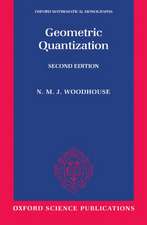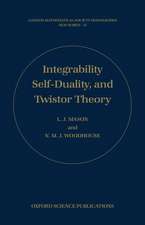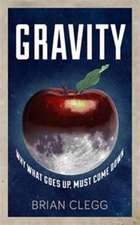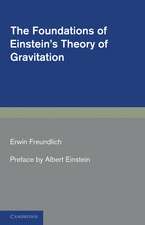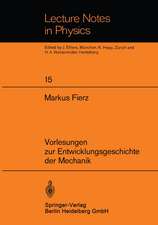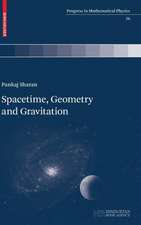General Relativity: Springer Undergraduate Mathematics Series
Autor N.M.J. Woodhouseen Limba Engleză Paperback – 11 dec 2006
In more practical terms, the book is a sequel to the author's Special Relativity in the same series, with some overlap in the treatment of tensors.
Din seria Springer Undergraduate Mathematics Series
-
 Preț: 319.90 lei
Preț: 319.90 lei -
 Preț: 237.41 lei
Preț: 237.41 lei -
 Preț: 319.02 lei
Preț: 319.02 lei -
 Preț: 325.20 lei
Preț: 325.20 lei -
 Preț: 238.28 lei
Preț: 238.28 lei -
 Preț: 237.29 lei
Preț: 237.29 lei -
 Preț: 265.92 lei
Preț: 265.92 lei -
 Preț: 236.87 lei
Preț: 236.87 lei -
 Preț: 236.97 lei
Preț: 236.97 lei -
 Preț: 240.63 lei
Preț: 240.63 lei -
 Preț: 237.18 lei
Preț: 237.18 lei -
 Preț: 283.11 lei
Preț: 283.11 lei -
 Preț: 359.15 lei
Preț: 359.15 lei -
 Preț: 358.55 lei
Preț: 358.55 lei -
 Preț: 221.92 lei
Preț: 221.92 lei -
 Preț: 224.54 lei
Preț: 224.54 lei -
 Preț: 358.82 lei
Preț: 358.82 lei -
 Preț: 301.10 lei
Preț: 301.10 lei -
 Preț: 383.17 lei
Preț: 383.17 lei -
 Preț: 229.86 lei
Preț: 229.86 lei -
 Preț: 268.37 lei
Preț: 268.37 lei -
 Preț: 166.75 lei
Preț: 166.75 lei -
 Preț: 239.86 lei
Preț: 239.86 lei -
 Preț: 266.70 lei
Preț: 266.70 lei -
 Preț: 269.99 lei
Preț: 269.99 lei - 15%
 Preț: 526.67 lei
Preț: 526.67 lei -
 Preț: 272.49 lei
Preț: 272.49 lei -
 Preț: 272.69 lei
Preț: 272.69 lei -
 Preț: 258.88 lei
Preț: 258.88 lei -
 Preț: 265.83 lei
Preț: 265.83 lei -
 Preț: 265.18 lei
Preț: 265.18 lei -
 Preț: 275.36 lei
Preț: 275.36 lei -
 Preț: 278.24 lei
Preț: 278.24 lei -
 Preț: 266.70 lei
Preț: 266.70 lei -
 Preț: 275.74 lei
Preț: 275.74 lei -
 Preț: 328.08 lei
Preț: 328.08 lei -
 Preț: 265.78 lei
Preț: 265.78 lei -
 Preț: 275.74 lei
Preț: 275.74 lei -
 Preț: 273.45 lei
Preț: 273.45 lei -
 Preț: 277.32 lei
Preț: 277.32 lei -
 Preț: 270.57 lei
Preț: 270.57 lei -
 Preț: 273.63 lei
Preț: 273.63 lei -
 Preț: 270.19 lei
Preț: 270.19 lei -
 Preț: 265.36 lei
Preț: 265.36 lei -
 Preț: 265.36 lei
Preț: 265.36 lei -
 Preț: 268.08 lei
Preț: 268.08 lei -
 Preț: 272.86 lei
Preț: 272.86 lei -
 Preț: 272.69 lei
Preț: 272.69 lei -
 Preț: 271.16 lei
Preț: 271.16 lei
Preț: 320.20 lei
Nou
Puncte Express: 480
Preț estimativ în valută:
61.28€ • 66.54$ • 51.47£
61.28€ • 66.54$ • 51.47£
Carte tipărită la comandă
Livrare economică 22 aprilie-06 mai
Preluare comenzi: 021 569.72.76
Specificații
ISBN-13: 9781846284861
ISBN-10: 1846284864
Pagini: 232
Ilustrații: X, 220 p. 33 illus.
Dimensiuni: 178 x 254 x 12 mm
Greutate: 0.38 kg
Ediția:2007
Editura: SPRINGER LONDON
Colecția Springer
Seria Springer Undergraduate Mathematics Series
Locul publicării:London, United Kingdom
ISBN-10: 1846284864
Pagini: 232
Ilustrații: X, 220 p. 33 illus.
Dimensiuni: 178 x 254 x 12 mm
Greutate: 0.38 kg
Ediția:2007
Editura: SPRINGER LONDON
Colecția Springer
Seria Springer Undergraduate Mathematics Series
Locul publicării:London, United Kingdom
Public țintă
Lower undergraduateCuprins
Newtonian Gravity.- Inertial Coordinates and Tensors.- Energy-Momentum Tensors.- Curved Space—Time.- Tensor Calculus.- Einstein’s Equation.- Spherical Symmetry.- Orbits in the Schwarzschild Space—Time.- Black Holes.- Rotating Bodies.- Gravitational Waves.- Redshift and Horizons.
Recenzii
From the reviews:
“This book introduces General Relativity at students level, especially intended for final year mathematics students. Different from other books with the same title, it really goes into the geometric details and tries to explain the given formulae … . The appendices present exercises and hints to their solutions.” (Philosophy, Religion and Science Book Reviews, bookinspections.wordpress.com, May, 2014)
"I have the opportunity to comment on General Relativity … . I am happy to recommend … for an advanced undergraduate course on relativity or for self-study. … marvelous faithfulness to historical developments … characterizes the entire treatment. … In fact, the whole book is distinguished by this high quality of exposition. … It’s a fine book, beautifully written and clear, and I highly recommend it." (Michael Berg, MathDL, January, 2007)
MAA Reviews:
In December, 2003 I had the pleasure of reviewing the admirable book Special Relativity, by N.M.J. Woodhouse, and now I have the opportunity to comment on General Relativity by the same author. I am happy to recommend not just this sequel, but the indicated pair, for an advanced undergraduate course on relativity or for self-study.
One particularly noteworthy feature of General Relativity is that woodhouse seeks to present the subject neither as a branch of differential geometry nor as the kind of physics mathematicians like me find unapproachable (and I'm afraid this doesn't particularly narrow the field). When just a rookie I dabbled in relativity largely from popularizations and biographical writings, and when I tried to learn some real general relativity in graduate school - for cultural reasons, I guess - it simply didn't take. But my interest in the subject, both specially and generally, has never flagged and Woodhouse’s books are tailor-made for even my lingering ambitions. In other words, for any slacker who feels heshould have learned this beautiful material in his mathematical youth, but didn’t, and is now secretly (or not so secretly) desirous of doing it right, this is the book, or, more correctly, these are the books to read. Furthermore, as I already hinted, as far as teaching courses on these important subjects is concerned, obviously these books fit that bill very well too, given Woodhouse’s specific pedagogical intent.
When it comes to the specific style and presentation of general relativity chosen by Woodhouse, marvellous faithfulness to historical developments, in particular Einstein’s own writings, characterizes the entire treatment. On p.7, already, the weak and strong equivalence principles are presented and analysed in a succinct and historically rooted fashion. The former, going back to Galileo’s pendulums (Woodhouse correctly says "pendula," of course) and famously connected with Eötvös’ experiment, entails that inertial mass and gravitational mass are the same; and the latter says that there are no obvservable differences between the local effects of gravity and acceleration. Woodhouse’s brief discussion of these observable differences between the local effects of gravity and acceleration. Woodhouse’s brief discussion of these incomparable axioms underlying Einstein’s revolution is a gem of exposition, covering the historical sweep of the attendant experiments (he even mentions a planned space experiment, "STEP," which will test the latter principle to within one part in 1018) and conveying what is to come as a result of these stipulations.
Finally, I want to draw special attention to pp.23-27, where Woodhouse does a phenomenally good job of explicating the subject of tensors in Minkowski space, a subject which has always been a bit unsettling to me who was raised to visit tensor products in their homological algebraic home and I cannot resist mentioning Problem 1.5 on p.13, dealing with "Einstein’sbirthday present."
It’s a fine book, beautifully written and clear, and I highly recommend it. [Reviewed by Michael Berg, 20.1.2007]
"Woodhouse … lets the physical intuition behind relativity inform every step of its logical development, making his treatment as digestible as any in print. He does introduce ab ovo what differential geometry he needs, and he takes the whole theory far enough to develop general relativity’s most exciting predictions, black holes and gravity waves, all in less than half the number of pages one might expect. Summing Up: Highly recommended. Upper-division undergraduates through professionals." (D. V. Feldman, CHOICE, Vol. 44 (11), July, 2007)
"The book is an outgrowth of a lecture course given over many years by the author and his colleagues to final-year applied mathematicians at the Mathematical Institute in Oxford, UK. The book is well-written and easy to follow because the author constructs the necessary apparatus layer-by-layer, from the bottom up, carefully motivating and justifying every new concept. Exercises are given at the end of every chapter … and numerous examples appear throughout the text. … its expository style is very appealing." (David A. Burton, General Relativity and Gravitation, Vol. 39, 2007)
“This book introduces General Relativity at students level, especially intended for final year mathematics students. Different from other books with the same title, it really goes into the geometric details and tries to explain the given formulae … . The appendices present exercises and hints to their solutions.” (Philosophy, Religion and Science Book Reviews, bookinspections.wordpress.com, May, 2014)
"I have the opportunity to comment on General Relativity … . I am happy to recommend … for an advanced undergraduate course on relativity or for self-study. … marvelous faithfulness to historical developments … characterizes the entire treatment. … In fact, the whole book is distinguished by this high quality of exposition. … It’s a fine book, beautifully written and clear, and I highly recommend it." (Michael Berg, MathDL, January, 2007)
MAA Reviews:
In December, 2003 I had the pleasure of reviewing the admirable book Special Relativity, by N.M.J. Woodhouse, and now I have the opportunity to comment on General Relativity by the same author. I am happy to recommend not just this sequel, but the indicated pair, for an advanced undergraduate course on relativity or for self-study.
One particularly noteworthy feature of General Relativity is that woodhouse seeks to present the subject neither as a branch of differential geometry nor as the kind of physics mathematicians like me find unapproachable (and I'm afraid this doesn't particularly narrow the field). When just a rookie I dabbled in relativity largely from popularizations and biographical writings, and when I tried to learn some real general relativity in graduate school - for cultural reasons, I guess - it simply didn't take. But my interest in the subject, both specially and generally, has never flagged and Woodhouse’s books are tailor-made for even my lingering ambitions. In other words, for any slacker who feels heshould have learned this beautiful material in his mathematical youth, but didn’t, and is now secretly (or not so secretly) desirous of doing it right, this is the book, or, more correctly, these are the books to read. Furthermore, as I already hinted, as far as teaching courses on these important subjects is concerned, obviously these books fit that bill very well too, given Woodhouse’s specific pedagogical intent.
When it comes to the specific style and presentation of general relativity chosen by Woodhouse, marvellous faithfulness to historical developments, in particular Einstein’s own writings, characterizes the entire treatment. On p.7, already, the weak and strong equivalence principles are presented and analysed in a succinct and historically rooted fashion. The former, going back to Galileo’s pendulums (Woodhouse correctly says "pendula," of course) and famously connected with Eötvös’ experiment, entails that inertial mass and gravitational mass are the same; and the latter says that there are no obvservable differences between the local effects of gravity and acceleration. Woodhouse’s brief discussion of these observable differences between the local effects of gravity and acceleration. Woodhouse’s brief discussion of these incomparable axioms underlying Einstein’s revolution is a gem of exposition, covering the historical sweep of the attendant experiments (he even mentions a planned space experiment, "STEP," which will test the latter principle to within one part in 1018) and conveying what is to come as a result of these stipulations.
Finally, I want to draw special attention to pp.23-27, where Woodhouse does a phenomenally good job of explicating the subject of tensors in Minkowski space, a subject which has always been a bit unsettling to me who was raised to visit tensor products in their homological algebraic home and I cannot resist mentioning Problem 1.5 on p.13, dealing with "Einstein’sbirthday present."
It’s a fine book, beautifully written and clear, and I highly recommend it. [Reviewed by Michael Berg, 20.1.2007]
"Woodhouse … lets the physical intuition behind relativity inform every step of its logical development, making his treatment as digestible as any in print. He does introduce ab ovo what differential geometry he needs, and he takes the whole theory far enough to develop general relativity’s most exciting predictions, black holes and gravity waves, all in less than half the number of pages one might expect. Summing Up: Highly recommended. Upper-division undergraduates through professionals." (D. V. Feldman, CHOICE, Vol. 44 (11), July, 2007)
"The book is an outgrowth of a lecture course given over many years by the author and his colleagues to final-year applied mathematicians at the Mathematical Institute in Oxford, UK. The book is well-written and easy to follow because the author constructs the necessary apparatus layer-by-layer, from the bottom up, carefully motivating and justifying every new concept. Exercises are given at the end of every chapter … and numerous examples appear throughout the text. … its expository style is very appealing." (David A. Burton, General Relativity and Gravitation, Vol. 39, 2007)
Notă biografică
Nick Woodhouse is an experienced researcher in GR with an international reputation.
Textul de pe ultima copertă
Based on a course given at Oxford over many years, this book is a short and concise exposition of the central ideas of general relativity. Although the original audience was made up of mathematics students, the focus is on the chain of reasoning that leads to the relativistic theory from the analysis of distance and time measurements in the presence of gravity, rather than on the underlying mathematical structure. The geometric ideas - which are central to the understanding of the nature of gravity - are introduced in parallel with the development of the theory, the emphasis being on laying bare how one is led to pseudo-Riemannian geometry through a natural process of reconciliation of special relativity with the equivalence principle. At centre stage are the "local inertial coordinates" set up by an observer in free fall, in which special relativity is valid over short times and distances.
In more practical terms, the book is a sequel to the author's Special Relativity in the same series, with some overlap in the treatment of tensors. The basic theory is presented using techniques, such as phase-plane analysis, that will already be familiar to mathematics undergraduates, and numerous problems, of varying levels of difficulty, are provided to test understanding. The latter chapters include the theoretical background to contemporary observational tests - in particular the detection of gravitational waves and the verification of the Lens-Thirring precession - and some introductory cosmology, to tempt the reader to further study.
While primarily designed as an introduction for final-year undergraduates and first-year postgraduates in mathematics, the book is also accessible to physicists who would like to see a more mathematical approach to the ideas.
In more practical terms, the book is a sequel to the author's Special Relativity in the same series, with some overlap in the treatment of tensors. The basic theory is presented using techniques, such as phase-plane analysis, that will already be familiar to mathematics undergraduates, and numerous problems, of varying levels of difficulty, are provided to test understanding. The latter chapters include the theoretical background to contemporary observational tests - in particular the detection of gravitational waves and the verification of the Lens-Thirring precession - and some introductory cosmology, to tempt the reader to further study.
While primarily designed as an introduction for final-year undergraduates and first-year postgraduates in mathematics, the book is also accessible to physicists who would like to see a more mathematical approach to the ideas.
Caracteristici
A concise introduction to the central ideas using mathematical techniques that are already familiar to mathematics undergraduates Includes links to recent developments, including discussions of further theoretical work and up-to-date observational evidence, to encourage further study. Includes numerous problems to test understanding


